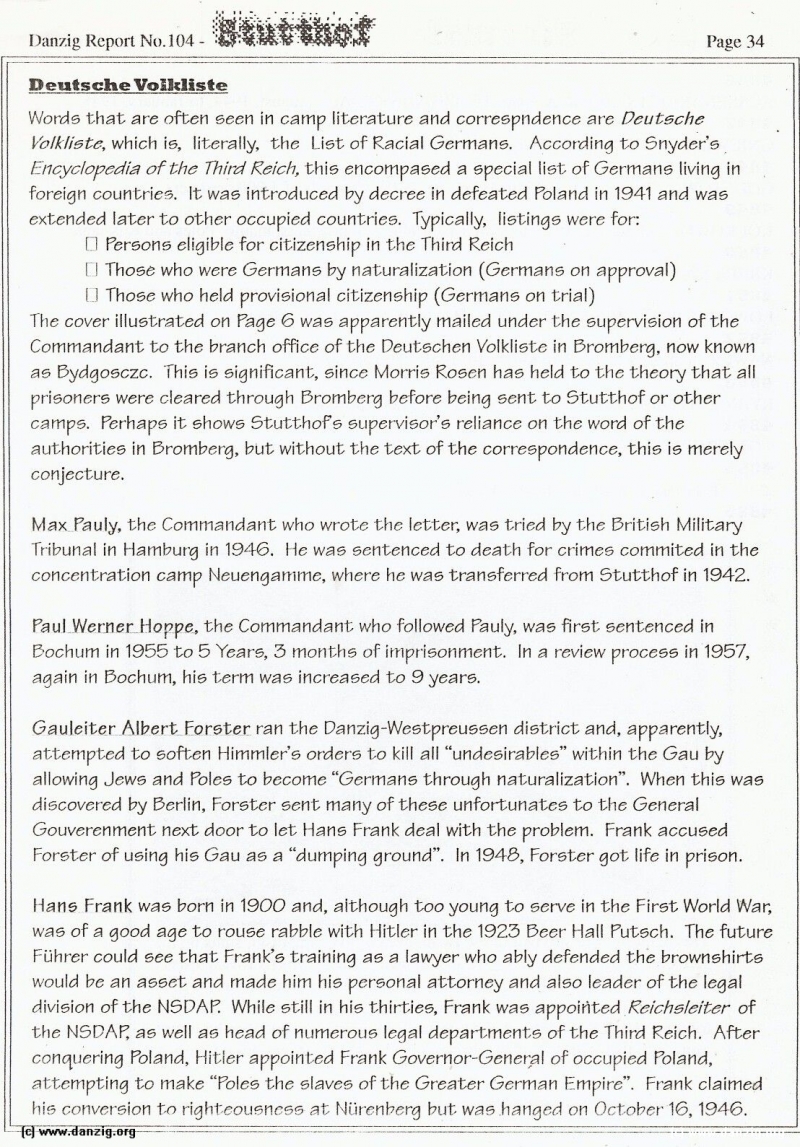
Deutsche Volkliste
Words that are often seen in camp literature and correspndence are Pcutchc Vo/kllstc, which is, literally, the List of Racial Germans. According to Snyder’s EncyclopedIa of thc Thira’ ,ccich, this encompased a special list of Germans living in foreign couritries. It was introduced by decree in defeated Poland in 1941 and was extended later to other occupied countries. Typically, listings were fon
Persons eligible for citizenship in the Third Reich
Those who were Germans by naturalization (Germans on approval)
Those who held provisional citizenship (Germans on trial)
The cover illustrated on Page 6 was apparently mailed under the supervision of the Commandant to the branch office of the Peutschen Volklistc in [3rom[’erg, now known as yc1gosczc. This is significant, since Morris Rosen has held to the theory that all prisoners were cleared through rombcrg before being sent to Stutthof or other camps. Perhaps it shows Stutthof’s supervisor’s reliance on the word of the authorities in ‘romberg, but without the text. of the correspondence, this is merely conjecture.
Max Pauly, the Commandant who wrote the letter, was tried by the british Military Tribunal in Hamburg in 1946. [Ic was sentenced to death for crimes commited in the concentration camp Neuengamme, where he was transferred from Stutthof in 1942.
Paul Werner Iloppe, the Commandant; who followed Pauly, was first sentenced in ‘ochum in 1955 to 5 Years, 3 months of imprisonment. In a review process in 1957, again in 5ochum, his term was increased to 9 years.
Gauleitcr Albert Forstcr ran the Panzig-Westpreussen district and, apparently, attempted to soften Himmler’s orders to kill all “undcsirables” within the Gau by allowing Jews and Poles to become “Germans through naturalization”. When this was discovered by crlin, Forstcr sent many of these unfortunates to the General Gouvercnment next door to let Hans Frank deal with the problem. Frank accused Forster of using his Gau as a “dumping ground”. In 1948’, Forster got life in prison.
Hans Frank was born in 1900 and, although too young to serve in the First World War, was of a good age to rouse rabble with Hitler in the 1923 beer Hall Putsch. The future Führer could see that Frank’s training as a lawyer who ably defended the brownshirts would be an asset and made him [us personal attorney and also leader of the legal division of the NSDAP While still in his thirties, Frank was appointed £cichlcitcr of the NSPAP as well as head of numerous legal departments of the Third Reich. After conquering Poland, Hitler appointed Frank Governor-Gener,al of occupied Poland, attempting to make “Poles the slaves of the Greater German Empire”. Frank claimed his conversion to righteousness at Nflrenherg hut. was hanged on October 16, 1946.
Danzig Report Vol. 1 - Nr. 104 - July - August - September - 1999, Page 37.
Hits: 3422
Added: 25/07/2015
Copyright: 2025 Danzig.org

